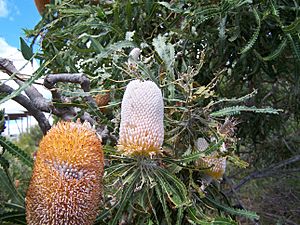George's taxonomic arrangement of Banksia facts for kids
Alex George's way of grouping Banksia plants was the first modern system for these amazing Australian plants. He first shared his ideas in 1981 in a special book called The genus Banksia L.f. (Proteaceae). His system took over from an older one by George Bentham that had been used for more than a hundred years! Later, in 1996, Kevin Thiele and Pauline Ladiges suggested a new way to group them. But Alex George brought his system back in 1999. Scientists are always learning new things, and a recent study by Austin Mast and Kevin Thiele suggests that the way Banksia plants are grouped might change again soon.
Contents
About Banksia Plants
Banksia is a group of about 80 different species (types) of plants. They belong to the plant family called Proteaceae. These plants are famous Australian wildflowers and are popular in gardens. You can easily spot them by their special flower spikes and "cones" that hold their seeds.
Banksia plants come in many shapes and sizes. Some are low-growing, woody shrubs, while others are tall trees that can reach up to 35 meters (about 115 feet) high! You can find them almost everywhere in Australia, except in the driest areas.
These plants make a lot of nectar, which is a sweet liquid. This makes them a very important food source for animals that eat nectar, like honeyeater birds and honey possums. Banksia plants are also important for businesses that grow plants for gardens (nurseries) and for selling flowers (cut flower industries).
Sadly, many Banksia species are in danger. They are threatened by things like land clearing (when their homes are removed), too many bushfires, and diseases. Because of this, some species are now considered rare or endangered.
The first Banksia plants were collected by Sir Joseph Banks and Dr Daniel Solander. They were naturalists on Lieutenant (who later became Captain) James Cook's ship, the Endeavour, during his trip to the Pacific Ocean in 1770. After that, many different ways of grouping Banksia plants were suggested in the 1800s. The system by George Bentham in 1870 was used for over a century.
How Scientists Group Banksia Plants
Scientists group living things to understand how they are related. This is called a "taxonomic arrangement." It's like organizing your toys into different boxes based on their type, size, or color. For plants, scientists look at features like flowers, leaves, and seeds.
Alex George's 1981 System
Alex George published his first modern system for grouping Banksia plants in 1981. He carefully studied all the known types of Banksia and put them into different categories:
- Big groups called subgenera (like main sections).
- Smaller groups called sections.
- Even smaller groups called series.
- And finally, individual species (the specific types of plants).
This detailed system helped other scientists understand the relationships between the many different Banksia plants.
Alex George's 1999 Update
In 1996, two other scientists, Kevin Thiele and Pauline Ladiges, suggested a new way to group Banksia plants. Their system was a bit different from George's.
However, in 1999, Alex George updated his original system. He mostly brought back his 1981 ideas. He also included some new Banksia types that had been discovered since 1981. He made a few small changes based on Thiele and Ladiges' work, but he didn't accept many of their bigger changes. This shows how scientists can have different ideas about how to group plants, and they often discuss and update these systems as new information comes in.
What Happened Next
Alex George's system was the main way scientists grouped Banksia plants from 1981 to 1996. Even though Thiele and Ladiges proposed a new system, George's updated version in 1999 was widely used again. However, not everyone agreed completely, and some plant collections (called herbaria) still followed some of Thiele and Ladiges' ideas.
In 2005, scientists Austin Mast, Eric Jones, and Shawn Havery used DNA information to study Banksia plants. They found that the relationships between the plants were very different from what Alex George's system showed. They even found that Banksia plants might be closely related to another group of plants called Dryandra.
Because of these new DNA findings, a new way of grouping Banksia plants is likely to be created soon. In 2007, Mast and Thiele started this process by moving Dryandra plants into the Banksia group. They also created a new subgroup called B. subg. Spathulatae for Banksia species with spoon-shaped cotyledons (the first leaves of a seedling). They plan to publish a complete new system once they have finished studying the DNA of all Dryandra plants.
Images for kids



